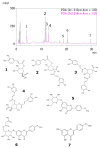Evaluation of Environmental Factor Effects on the Polyphenol and Flavonoid Content in the Leaves of Chrysanthemum indicum L. and Its Habitat Suitability Prediction Mapping
- PMID: 38474439
- PMCID: PMC10934983
- DOI: 10.3390/molecules29050927
Evaluation of Environmental Factor Effects on the Polyphenol and Flavonoid Content in the Leaves of Chrysanthemum indicum L. and Its Habitat Suitability Prediction Mapping
Abstract
The leaves of Chrysanthemum indicum L. are known to have various bioactive compounds; however, industrial use is extremely limited. To overcome this situation by producing high-quality leaves with high bioactive content, this study examined the environmental factors affecting the phytochemical content and antioxidant activity using C. indicum leaves collected from 22 sites in Kochi Prefecture, Japan. Total phenolic and flavonoid content in the dry leaves ranged between 15.0 and 64.1 (mg gallic acid g-1) and 2.3 and 11.4 (mg quercetin g-1), while the antioxidant activity (EC50) of the 50% ethanol extracts ranged between 28.0 and 123.2 (µg mL-1) in 1,1-Diphenyl-2-picrylhydrazyl radical scavenging assay. Among the identified compounds, chlorogenic acid and 1,5-dicaffeoylquinic acid were the main constituents in C. indicum leaves. The antioxidant activity demonstrated a positive correlation with 1,5-dicaffeoylquinic acid (R2 = 0.62) and 3,5-dicaffeoylquinic acid (R2 = 0.77). The content of chlorogenic acid and dicaffeoylquinic acid isomers varied significantly according to the effects of exchangeable magnesium, cation exchange capacity, annual temperature, and precipitation, based on analysis of variance. The habitat suitability map using the geographical information system and the MaxEnt model predicted very high and high regions, comprising 3.2% and 10.1% of the total area, respectively. These findings could be used in future cultivation to produce high-quality leaves of C. indicum.
Keywords: 1,5-dicaffeoylquinic acid; 3,5-dicaffeoylquinic acid; Chrysanthemum indicum; MaxEnt; antioxidant; chlorogenic acid; geographic information system.
Conflict of interest statement
The authors declare no conflicts of interest.
Figures









Similar articles
-
Phenolic Characterization and Antioxidant Activity of Chrysanthemum indicum and Opisthopappus Shih during Different Growth Stages.Chem Biodivers. 2023 Jul;20(7):e202300370. doi: 10.1002/cbdv.202300370. Epub 2023 Jun 16. Chem Biodivers. 2023. PMID: 37263981
-
Bioactive compounds and antioxidants from a Mediterranean garland harvested at two stages of maturity.Nat Prod Res. 2017 Dec;31(24):2941-2944. doi: 10.1080/14786419.2017.1305384. Epub 2017 Mar 17. Nat Prod Res. 2017. PMID: 28301955
-
Antioxidant activity and total phenolic and flavonoids content variations of leaves extracts of white Horehound (Marrubium vulgare Linné) from three geographical origins.Ann Pharm Fr. 2016 Nov;74(6):453-462. doi: 10.1016/j.pharma.2016.07.002. Epub 2016 Aug 21. Ann Pharm Fr. 2016. PMID: 27553439
-
Chrysanthemum indicum L.: A Comprehensive Review of its Botany, Phytochemistry and Pharmacology.Am J Chin Med. 2020;48(4):871-897. doi: 10.1142/S0192415X20500421. Epub 2020 May 20. Am J Chin Med. 2020. PMID: 32431180 Review.
-
Research progress on extraction and purification, structural characteristics, pharmacological activities, structure-activity relationships, and applications of Chrysanthemum indicum L. polysaccharides: A review.Int J Biol Macromol. 2025 Jun;315(Pt 2):144689. doi: 10.1016/j.ijbiomac.2025.144689. Epub 2025 May 26. Int J Biol Macromol. 2025. PMID: 40436174 Review.
Cited by
-
Predicting the potential habitats of two Lycium species and the quality suitability of Lycium chinense Mill. Cortex under climate change.BMC Ecol Evol. 2025 Jul 30;25(1):74. doi: 10.1186/s12862-025-02413-8. BMC Ecol Evol. 2025. PMID: 40739175 Free PMC article.
-
Responses of Intestinal Antioxidant Capacity, Morphology, Barrier Function, Immunity, and Microbial Diversity to Chlorogenic Acid in Late-Peak Laying Hens.Animals (Basel). 2024 Oct 14;14(20):2957. doi: 10.3390/ani14202957. Animals (Basel). 2024. PMID: 39457887 Free PMC article.
-
Enhancing Germination and Growth of Chrysanthemum Synthetic Seeds Through Iron Oxide Nanoparticles and Indole-3-Acetic Acid: Impact of Treatment Duration on Metabolic Activity and Genetic Stability.Nanotechnol Sci Appl. 2025 Mar 18;18:139-155. doi: 10.2147/NSA.S503868. eCollection 2025. Nanotechnol Sci Appl. 2025. PMID: 40125333 Free PMC article.
-
Chemical Composition Analysis of Sea Buckthorn (Hippophae) in Georgia and Development of Innovative Valorization Technologies.Food Sci Nutr. 2025 Jul 14;13(7):e70507. doi: 10.1002/fsn3.70507. eCollection 2025 Jul. Food Sci Nutr. 2025. PMID: 40661806 Free PMC article.
References
-
- Hadizadeh H., Samiei L., Shakeri A. Chrysanthemum, an Ornamental Genus with Considerable Medicinal Value: A Comprehensive Review. S. Afr. J. Bot. 2022;144:23–43. doi: 10.1016/j.sajb.2021.09.007. - DOI
-
- Society of Japanese Pharmacopoeia . The Japanese Pharmacopoeia. 18th ed. Pharmaceuticals and Medical Devices Agency; Tokyo, Japan: 2021.
-
- Gong J., Chu B., Gong L., Fang Z., Zhang X., Qiu S., Wang J., Xiang Y., Xiao G., Yuan H., et al. Comparison of Phenolic Compounds and the Antioxidant Activities of Fifteen Chrysanthemum morifolium Ramat Cv. ‘Hangbaiju’ in China. Antioxidants. 2019;8:325. doi: 10.3390/antiox8080325. - DOI - PMC - PubMed
MeSH terms
Substances
LinkOut - more resources
Full Text Sources

